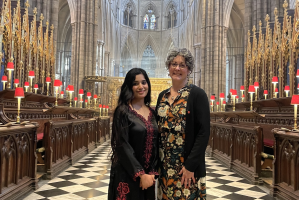Rubens and Women at Dulwich Picture Gallery

The Virgin in Adoration before the Christ Child. Peter Paul Rubens, 1616-19 Snyders and Rockox House Museum, Antwerp
A joyous artistic celebration of Rubens and Women at Dulwich Picture Gallery celebrates his faith and family in portrayals of female figures, capturing their personalities and soul.
Over 40 paintings and drawings examine aspects of his artistry, some never seen in the UK before. Considered the greatest living artist of his time, he was also a collector and diplomat. Both King Charles I of England and King Philip IV of Spain conferred knighthoods on him for his services.
Born in Siegen in Westphalia, Germany, Peter Paul Rubens, his mother and siblings returned to Antwerp, the family's original home, following his fathers' death in 1589. After briefly acting as a page to Flemish nobility, Rubens trained as an artist and in 1598 registered as an independent artist with the Guild of St Luke in Antwerp.
Initially he concentrated on portraiture, aiming to make a name for himself before pursuing his preferred historical and religious narratives.
A devout Catholic, Rubens attended Mass twice daily. His artistic output was prodigious, creating 15,000 paintings, 450 oil sketches and many drawing during his lifetime. He also wrote around 8,000 letters of which 250 survive casting light on his relationships with friends and family.
Aged 22 he travelled to Italy, finding inspiration in Titian, Raphael, and Michelangelo, and worked for the Duke of Mantua. After eight years he returned home in 1608 on hearing his mother was dying. Antwerp was part of the Spanish Netherlands and ruled by the Infanta of Spain and her husband Archduke Albert. They employed Rubens as their court painter and after marrying Isabella Brabant, he purchased the imposing Rubenshuis the following year.
He married twice, firstly to Isabella Brant. He was grief stricken when she died, probably from the plague in 1626. In 1630 he married youthful Helena Fourment. She features in all of his works during the last 10 years of his life as a vibrant model.
The exhibition begins with stunning female portraiture entitled, Face to Face with Rubens. His great skill at sympathetically depicting female personalities is highlighted.
An imposing portrait of a Genoese noblewoman, probably Marchesa Maria Serra Pallavicino dominates the room. Dressed in a sumptuous white satin gown trimmed with gold braid and large ruff, she sits authoritatively, animated by a hint of a smile and ponderous soft brown eyes.
An intimate small portrait of The Infanta Isabella Clara Eugenia, wearing the habit of a Poor Clare, which she wore as a member of the Franciscan Third Order after her husband's death, is outstanding. She had a long association with the Convent of the Discalced Poor Clares for which the artist completed 20 tapestries celebrating the Eucharist. Rubens' diplomatic services and friendship were highly valued by her. Isabella's Hapsburg features radiate warmth and shrewdness as she smiles perceptively at the onlooker.
Possibly on Isabella's recommendation Rubens painted a cycle of paintings of Marie de Medici. A preparatory drawing in 1622, captures this formidable and powerful Queen of France, second wife of Henry IV and mother of Louis XIII.
His family portraits exude sensitivity and exquisite tenderness, especially in the heartbreaking drawing of his fragile daughter Clara, just months from death before her 13th birthday. Her love for her father is evident from her adoring gaze. Alongside her is her mother's memorial portrait whose facial similarity is clearly defined particularly the shared penetrating eyes and rosebud mouths. A distinctive signed self-portrait is from the Royal Collection.
Entitled Figuring Faith, Room Two abounds with riveting studies of saints featuring in large scale altar panels or for private devotional use.
A charming chalk drawing of the martyr St Apollonia, patron of dentists is almost a. portrait in itself. Apollonia was to feature in an altar piece for Antwerp's Augustinian church.
'The Lamentation', 1614, in oil on oak and on loan from Vienna, powerfully focuses on the women around the dead Christ. St John is almost an extra in the scene! An anguished Mary Magdalene pulls distractedly at her hair as Christ's mother cradles her son, gently closing his eyes. The three Marys weep at his feet, one raising her eyes heavenwards.
'The Virgin in Adoration before Christ' 1616-19, an oil on panel, is a tender portrayal of Mary lovingly gazing down at her sleeping child. His first wife Isabella and either his son Albert or Nicholas were the models for this deeply reflective picture.
The next room, Stone Made Flesh is a study of Rubens traditional nudes inspired by classical sculpture, in drawings and sketches. An early work by a youthful Rubens is a monumental painting of Adam and Eve in Paradise. A confident Eve is poised to eat the apple whilst Adam is crouched, his hand outstretched in anticipation.
Concluding with The Goddesses of Peace and Plenty room vast canvases include 'The Birth of the Milky Way' on loan from the Prado Madrid seen for the first time in the UK and 'Diana Returning from the Hunt' from Dresden.
Rubens infused his depictions of women "with veracity, energy and soul" as described by co- curator Dr.van Beneden, former director of the Rubenshuis. This wonderful exhibition throws new light on Rubens portrayals of real women rather than the 'Rubenesque' myths that frequently pervade perceptions of his art.
The exhibition runs from Tuesday-Sunday until 28 January 2024
Admission £7.50 -£15
For more details see: www.dulwichpicturegallery.org.uk


















